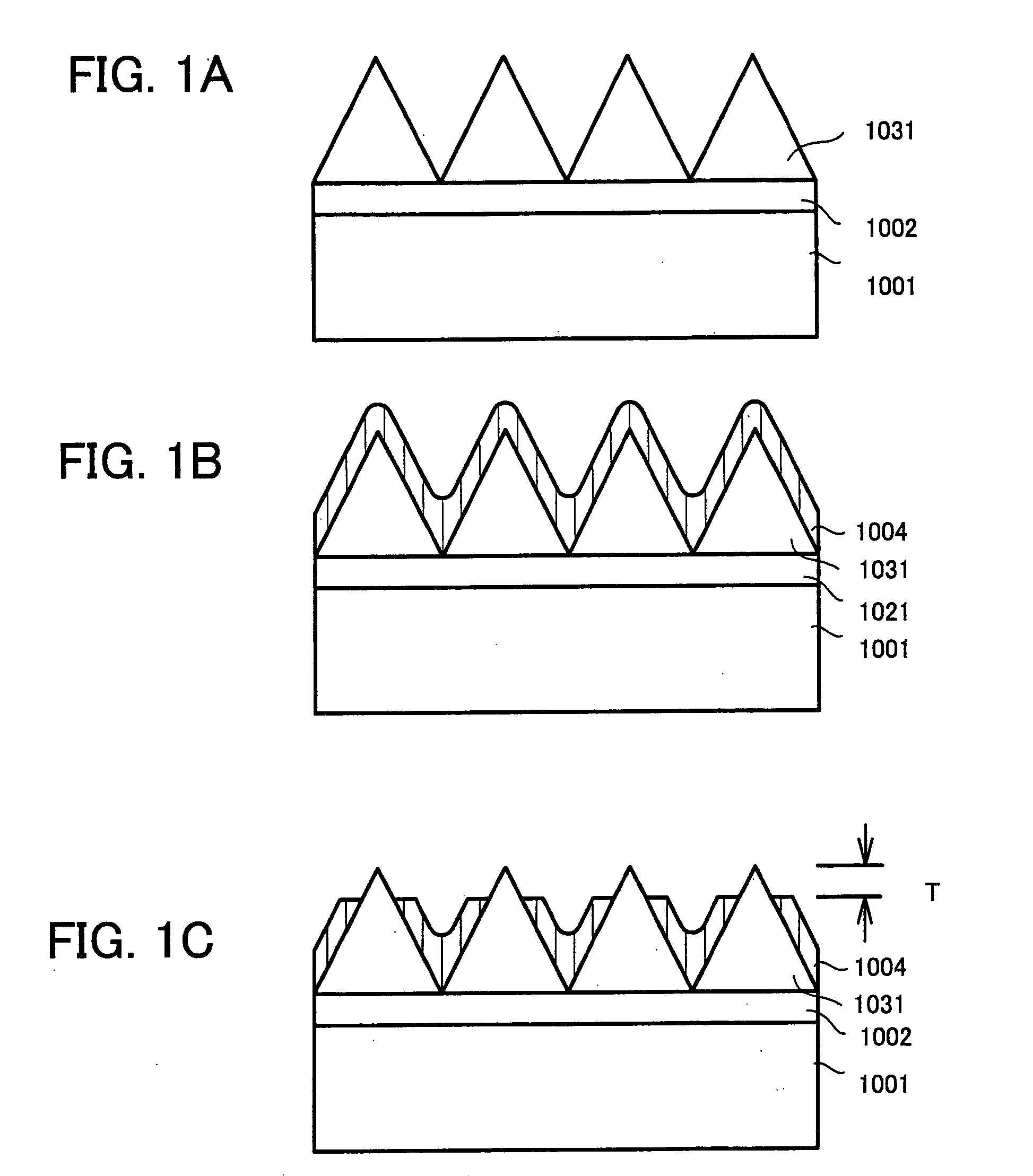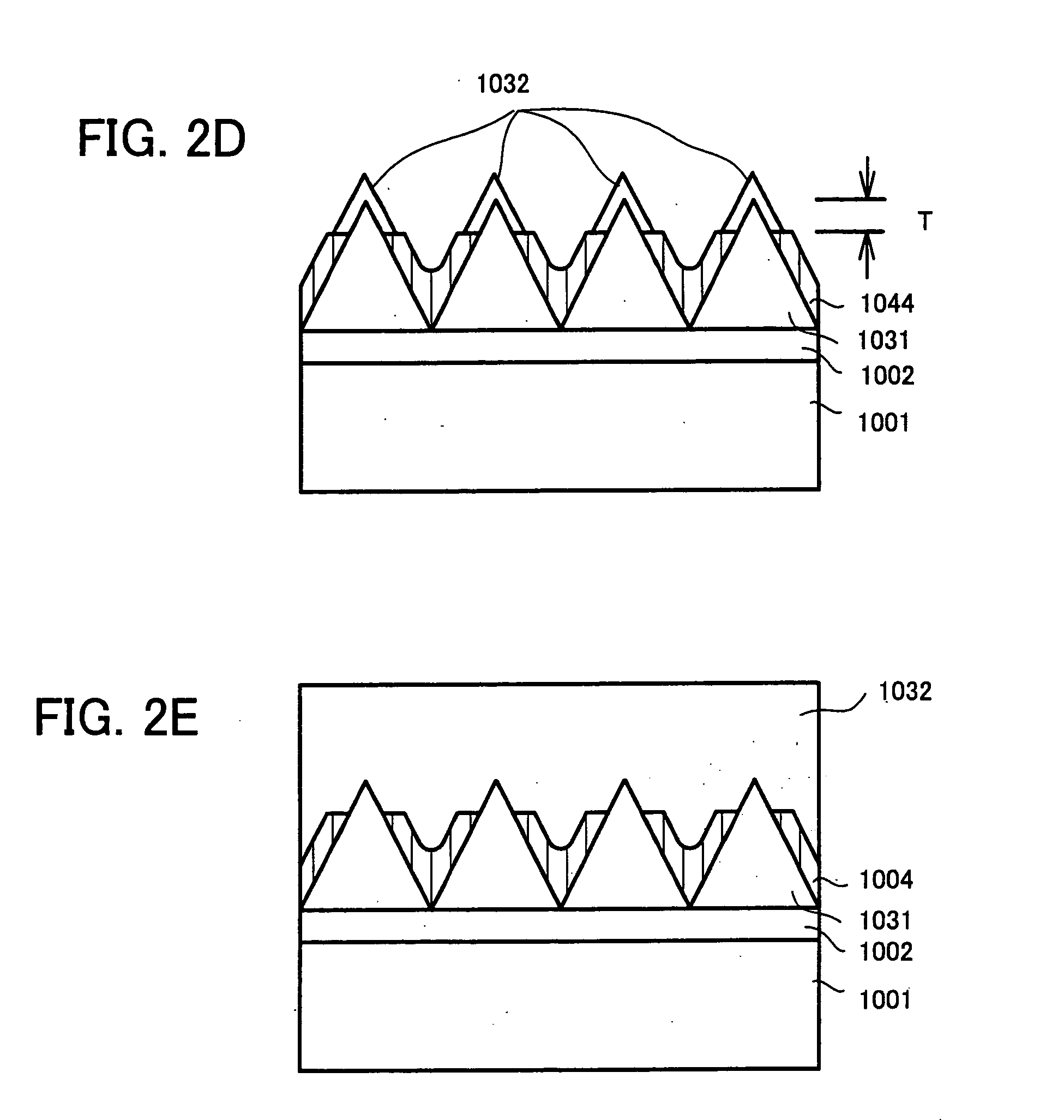Method for fabricating group III nitride compound semiconductors and group III nitride compound semiconductor devices
a technology of nitride compound semiconductors and compound semiconductors, which is applied in the direction of solid-state devices, crystal growth processes, chemical instruments and processes, etc., can solve the problems of poor device characteristics, low mobility of semiconductor devices, and device problems of unsatisfactory device characteristics, so as to suppress the generation of dislocations, reduce the generation of strain, and reduce the effect of strain
- Summary
- Abstract
- Description
- Claims
- Application Information
AI Technical Summary
Benefits of technology
Problems solved by technology
Method used
Image
Examples
first embodiment
[0094]FIGS. 1 and 2 show the steps of the present embodiment. A monocrystalline sapphire substrate 1001 containing an a-plane as a primary crystal plane was cleaned through organic cleaning and heat treatment. The temperature of the substrate 1001 was lowered to 400° C., and H2 (10 L / min), NH3 (5 L / min), and TMA (20 μmol / min) were fed for about three minutes, to thereby form an AlN buffer layer 1002 (thickness: about 40 nm) on the substrate 1001. Subsequently, the temperature of the sapphire substrate 1001 was maintained at 1,000° C., and H2 (20 L / min), NH3 (10 L / min), and TMG (300 μmol / min) were introduced, to thereby form a GaN layer 1031 (thickness: about 2 μm).
[0095] Subsequently, the GaN layer 1031 was subjected to selective dry etching by means of reactive ion beam etching (RIBE), to thereby form mesas in the form of laterally aligned triangular prisms (length of the base of the cross section of each prism: 2 μm, height of the cross section: 2 μm) (FIG. 1A). The angle formed ...
second embodiment
[0098] In the present embodiment, as shown in FIGS. 4 and 5, an underlying layer including multiple layers was employed. A monocrystalline sapphire substrate 1001 having an a-plane as a primary crystal plane was cleaned through organic cleaning and heat treatment. The temperature of the substrate 1001 was lowered to 400° C., and H2 (10 L / min), NH3 (5 L / min), and TMA (20 μmol / min) were fed for about three minutes, to thereby form a first AlN layer (first buffer layer) 1021 (thickness: about 40 nm) on the substrate 1001. Subsequently, the temperature of the sapphire substrate 1001 was maintained at 1,000C, and H2 (20 L / min), NH3 (10 L / min), and TMG (300 μmol / min) were introduced, to thereby form a GaN layer (intermediate layer) 1022 (thickness: about 0.3 μm). Subsequently, the temperature of the substrate 1001 was lowered to 400° C., and H2 (10 L / min), NH3 (5 L / min), and TMA (20 μmol / min) were fed for about three minutes, to thereby form a second AlN layer (second buffer layer) 1023 (...
third embodiment
[0101] In the present embodiment, the first embodiment was modified such that, in formation of the GaN layer 1031, the GaN layer 1031 was doped with TMI to become a GaN:In layer 1031. The doping amount of indium (In) was regulated to about 1×1016 / cm3. Subsequently, in a manner substantially similar to that of the first embodiment, etching was performed; a tungsten mask 1004 was formed; the GaN:In layer 1031 was subjected to selective etching to thereby expose tops of the layer 1031; and lateral epitaxial growth of GaN was performed. The threading dislocations contained in a GaN layer 1032 which was laterally grown on the GaN:In layer 1031 serving as nuclei for crystal growth were slightly reduced in number as compared with those contained in the GaN layer 1032 formed in the first embodiment.
PUM
| Property | Measurement | Unit |
|---|---|---|
| temperature | aaaaa | aaaaa |
| temperature | aaaaa | aaaaa |
| thickness | aaaaa | aaaaa |
Abstract
Description
Claims
Application Information
 Login to View More
Login to View More - R&D
- Intellectual Property
- Life Sciences
- Materials
- Tech Scout
- Unparalleled Data Quality
- Higher Quality Content
- 60% Fewer Hallucinations
Browse by: Latest US Patents, China's latest patents, Technical Efficacy Thesaurus, Application Domain, Technology Topic, Popular Technical Reports.
© 2025 PatSnap. All rights reserved.Legal|Privacy policy|Modern Slavery Act Transparency Statement|Sitemap|About US| Contact US: help@patsnap.com



